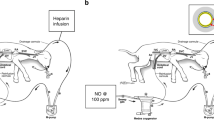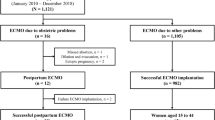Abstract
Extracorporeal membrane oxygenation (ECMO) has been successful as a rescue therapy for infants with respiratory failure with some diagnoses such as meconium aspiration syndrome (MAS) having a survival rate of more than 94%. New therapies have allowed many infants who would have required ECMO to be kept off ECMO, but at what cost. The survival rate for the neonatal ECMO patient has dropped over the years, whereas the time of ECMO has increased, indicating that the new therapies are keeping the less ill infants off ECMO. The major cause of non-survival in this population remains intraventricular hemorrhage. The primary risk factors related to this are thought to be pre-ECMO events, such as hypoxia and/or ischemia either prenatally or post-delivery. ECMO events that may complicate this are heparinization that is required while on ECMO and concern for the effect of shear stress and blood flow pattern changes created by the ECMO pump with venoarterial ECMO, although these changes are not seen in venovenous ECMO, the more common form of ECMO. Newer low-resistant microporous artificial lungs and miniaturized pumping systems may allow ECMO to be performed using less blood and safer equipment. The smaller low-resistant artificial lungs provide the ability to consider giving extracorporeal life support using only this membrane with flow provided by an arterial–venous shunt, thus eliminating the pumping system all together. Trials are ongoing in adults and, if effective, may direct further research into using this technique in newborns where the umbilical artery and vein could be used as the arterial–venous shunt.
This is a preview of subscription content, access via your institution
Access options
Subscribe to this journal
Receive 12 print issues and online access
$259.00 per year
only $21.58 per issue
Buy this article
- Purchase on Springer Link
- Instant access to full article PDF
Prices may be subject to local taxes which are calculated during checkout







Similar content being viewed by others
References
Rais-Bahrami K, VanMeurs K . ECMO for neonatal respiratory failure. Semin Perinatol 2005; 29: 15–23.
Thompson BT, Spence CR, Janssens SP, Joseph PM, Hales CA . Inhibition of hypoxic pulmonary hypertension by heparins of differing in vitro antiproliferative potency. Am J Respir Crit Care Med 1994; 149 (6): 1512–1517.
White JJ, Risemberg H, Andrews HG, Mazur D, Haller Jr JA . Prolonged respiratory support in newborn infants with a membrane oxygenator. Surgery 1971; 70: 288–296.
Dorson WJ, Baker E, Cohen MI, Meyer B, Molthan M, Trump A et al. A perfusion system for infants. ASAIO Trans 1969; 15: 155–160.
Bartlett RH, Gazzaniga AB, Jefferies R, Huxtable RF, Haiduc NJ, Fong SW et al. Extracorporeal membrane oxygenation (ECMO) cardiopulmonary support in infancy. Trans Am Soc Artif Intern Organs 1976; 22: 80–88.
Bulas D, Glass P . Neonatal ECMO: neuroimaging and neurodevelopmental outcome. Semin Perinatol 2005; 29: 58–65.
Short BL . The effect of extracorporeal life support on the brain: a focus on ECMO. Semin Perinatol 2005; 29: 45–50.
Short BL, Walker LK, Gleason CA, Bender KS, Traystman RJ . Effect of extracorporeal membrane oxygenation on cerebral blood flow and cerebral oxygen metabolism in newborn seep. Pediatr Res 1990; 28: 50–53.
Short BL, Walker LK, Bender KS, Traystman RJ . Impairment of cerebral autoregulation during extracorporeal membrane oxygenation in newborn lambs. Pediatri Res 1993; 33: 289–294.
Ingyinn M, Lee J, Short BL, Viswanathan M . Venoarterial extracorporeal membrane oxygenation (VA ECMO) impairs basal nitric oxide production in cerebral arteries of newborn lambs. Pediatr Crit Care Med 2000; 1: 161–165.
Ingyinn I, Short BL, Rais-Bahrami K, Viswanathan M . Altered cerebrovascular responses after exposure to venoarterial extracorporeal membrane oxygenation: role of the nitric oxide pathway. Pediatr Crit Care Med 2006; 7 (4): 368–373.
The Neonatal Inhaled Nitric Oxide Group. Inhaled nitric oxide in full-term and near-term infants in respiratory failure. N Engl J of Med 1997; 336: 597–604.
Clark RH, Kueser TJ, Walker MW, Southgate WM, Huckaby JL, Perez JA et al. Low-dose nitric oxide therapy for persistent pulmonary hypertension of the newborn. N Engl J Med 2000; 342: 469–474.
Walker LK, Short BL, Traystman RH . Impairment of cerebral autoregulation during venovenous extracorporeal membrane oxygenation in the newborn lamb. Crit Care Med 1996; 24: 2001–2006.
Fliman PJ, DeRegnier RA, Kinsella JP, Reynolds M, Rankin LL, Steinhorn RH . Neonatal extracorporeal life support: impact of new therapies on survival. J of Pediatr 2006; 148: 595–599.
Radhakrishnan RS, Lally PA, Cox CS . ECMO for meconium aspiration syndrome: support for relaxed entry criteria. ASAIO J 2007; 53: 489–491.
Hines MH . ECMO and congenital heart disease. Semin Perinatol 2005; 29: 34–39.
Bartlett RH . Extracorporeal life support: history and new directions. Semin Perinatol 2005; 29: 2–7.
Wales T . Clinical experience with the iLA membrane ventilator pumpless extracorporeal lung-assist device (review). Expert Rev Med Devices 2997; 4 (3): 297–305.
Bein T, Weber F, Philipp A, Prasser C, Pfeifer M, Schmid FX et al. A new pumpless extracorporeal interventional lung assist in critical hypoxemia/hypercapnia. Crit Care Med 2006; 34 (5): 1371–1377.
Liebold A, Reng CM, Philipp A, Pfeifer M, Birnbaum DE . Pumplesss extracorporeal lung assist-experience with the first 20 cases. Eur J Cardiothorac Surg 2000; 17 (5): 608–613.
Author information
Authors and Affiliations
Corresponding author
Additional information
Disclosure
The author has declared no financial interests.
Rights and permissions
About this article
Cite this article
Short, B. Extracorporeal membrane oxygenation: use in meconium aspiration syndrome. J Perinatol 28 (Suppl 3), S79–S83 (2008). https://doi.org/10.1038/jp.2008.152
Published:
Issue Date:
DOI: https://doi.org/10.1038/jp.2008.152
This article is cited by
-
Lung ultrasound for the assessment of lung recruitment in neonates with massive pneumothorax during extracorporeal membrane oxygenation: a case report
Journal of Artificial Organs (2022)
-
Neonatologists and non-vigorous newborns with meconium-stained amniotic fluid (MSAF) in the delivery room: time for hands off?
European Journal of Pediatrics (2019)
-
Current Concepts in the Management of Meconium Aspiration Syndrome
The Indian Journal of Pediatrics (2016)



